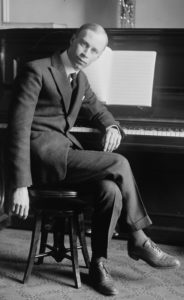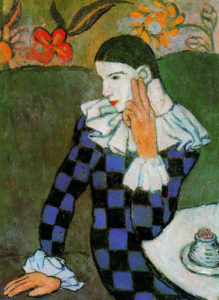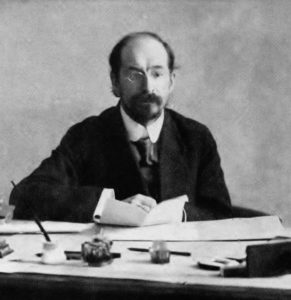On October 22, 23, & 24, Dame Jane Glover leads the Houston Symphony in Mendelssohn’s Scottish Symphony. The program also features Prokofiev’s Symphony No. 1, which we last performed in September 2018. In the post below, learn more about one of Prokofiev’ most-loved works, his “Classical” Symphony.
At first, Prokofiev was not overly troubled by the outbreak of the Russian Revolution in February 1917; he even indulged in some revolutionary sightseeing during its early days, venturing out of his Petrograd apartment to observe the protests while avoiding the bullets as best he could. For the most part, however, musical life continued undisturbed, and Prokofiev composed, practiced and went to concerts and rehearsals as before. Despite some chaos and confusion, it seemed that 300 years of oppressive Romanov rule would at last be replaced by some sort of constitutional democracy, an outcome that the composer optimistically embraced.

In addition to being a genius composer, Prokofiev was a voluminous and eloquent diarist. Shortly after his 26th birthday in April, he determined to find “some green spot where I could both work and walk” during the summer months. He settled on an idyllic farm just outside the capital. “The main advantage,” he explained, “was that the farm would provide delicious and wholesome food, whereas most dacha-dwellers [a dacha is a kind of small summer house in the countryside] from Petrograd were finding it literally hard to find anything at all to eat.” It was in this island of tranquility that he would compose one of his best-loved works, his “Classical” Symphony.
“Musically I also took an important decision: to do without a piano,” he wrote. In some circles, using a piano to compose was seen as a crutch; the true master was supposed to be able to compose everything in his head. More significant, however, was his overall approach to the symphony. In an era when symphonies were often sprawling, emotionally wrought works, Prokofiev decided to subvert expectations by composing his first symphony along Mozartian lines. It would be concise and playful, updating traditional classical forms with modern harmonies, rhythms and orchestral colors. Throughout, Prokofiev wittily juxtaposes his own daring musical language with typical melodic turns and gestures from Mozart’s time.
Classical Pearls and Prokofievish Dissonances
“When our classically inclined musicians and professors (to my mind faux-classical) hear this symphony, they will be bound to scream in protest at this new example of Prokofiev’s insolence,” he opined to his diary. “[L]ook how he will not let even Mozart lie quiet in his grave but must come prodding at him with his grubby hands, contaminating the pure classical pearls with horrible Prokofievish dissonances,” he imagined them saying. “But my true friends will see that the style of my symphony is precisely Mozartian classicism and will value it accordingly, while the public will no doubt just be content to hear happy and uncomplicated music which it will, of course, applaud.” On that account he was exactly right; with its impish sense of humor, impeccable craftsmanship and charming melodies, the symphony was a breath of fresh air, and it has remained one of the composer’s most popular works.
After an introductory flourish, the first movement proceeds according to Mozartian formal principals; a bright, skittering main theme leads to a simpler second theme in the violins, which features large leaps from high notes to low notes. Despite his adventurous harmonies, Prokofiev presents this second theme in the traditional key—a fifth higher than that of the opening theme—as if to cheekily reassure his critics that everything is perfectly correct according to textbook definitions of how a symphony should unfold. The two themes are then developed in a more tumultuous section before being reprised.

The second movement is a more relaxed Larghetto. After four introductory bars, a melody appears high in the violins, full of Mozartian trills and lilting figures. Alternating with contrasting episodes, this melody returns twice with varied harmonies and accompaniments. The movement ends just as it began with the return of the introductory measures.
In place of the usual minuet that Mozart would have written, Prokofiev substitutes a different eighteenth-century dance for the third movement: a gavotte, which is typically in a 4/4 meter and begins with two prominent upbeats. This brief, charming movement recalls the faux-classical dances Tchaikovsky wrote for Sleeping Beauty, albeit with a Prokofievish twist.
In his diary, Prokofiev noted that he “scrapped” the original finale he had written for the symphony because it “seemed to me too ponderous and not characterful enough for a classical symphony.” His friend, the composer and musicologist Boris Asafyev, “put into my mind an idea he was developing, that there is no true joyfulness to be found in Russian music. Thinking about this, I composed a new finale, lively and blithe enough for there to be a complete absence of minor triads in the whole movement, only major ones. From my original finale I salvaged only the second subject. I found the movement extraordinarily easy to write, and the only thing I was concerned with was that its gaiety might border on the indecently irresponsible. But in the first place it never actually crosses this line, and in the second, this kind of finale is quite appropriate to Mozartian style. I was hugging myself with delight all the time I was composing it!”
Indecently irresponsible? Perhaps, but it is great fun all the same. Featuring virtuoso parts for flutes and oboes, this sparkling finale brings the symphony to a breathless ending.
What do you want to go to America for?

Prokofiev finished the symphony in September, and the premiere was scheduled for November 4. It had to be rescheduled, however, due to the Bolshevik coup in October. Though Prokofiev was far from the revolutionary furor (he was visiting a scenic spot in the Caucasus), reports of the Bolshevik takeover led him to decide to emigrate as soon as possible. Back in Petrograd, he met with the new People’s Commissariat for Education, Anatoly Lunacharsky, in order to obtain permission to go abroad. Prokofiev recalled his surreal interview with the Commissariat: “’You ought to stay here, what do you want to go to America for?’ ‘I’ve worked for a year and now I want to get some fresh air.’ ‘We have all the fresh air you could want in Russia.’ ‘But that is in the moral sense, and my present need for air is a purely physical one. Just think of it, to be cutting diagonally right across the Pacific ocean!’ ‘All right, just fill in this form and we’ll give you the necessary papers.’”
Prokofiev then invited the Commissariat to the rehearsal of his new symphony, the premiere of which at last took place in April 1918. “This was amazing! Fantastic!” Prokofiev noted. “The Symphony went marvelously and was a huge success.” A few weeks later he was on the Trans-Siberian railroad headed to Vladivostok. From there he would travel by way of Japan to the United States, where he would try to make his name in the new world. —Calvin Dotsey
In-hall and livestream tickets are still available for this weekend’s performance of Mendelssohn’s Scottish Symphony, featuring Prokofiev’s Symphony No. 1 on the program.
Blog originally written in September 2018.



